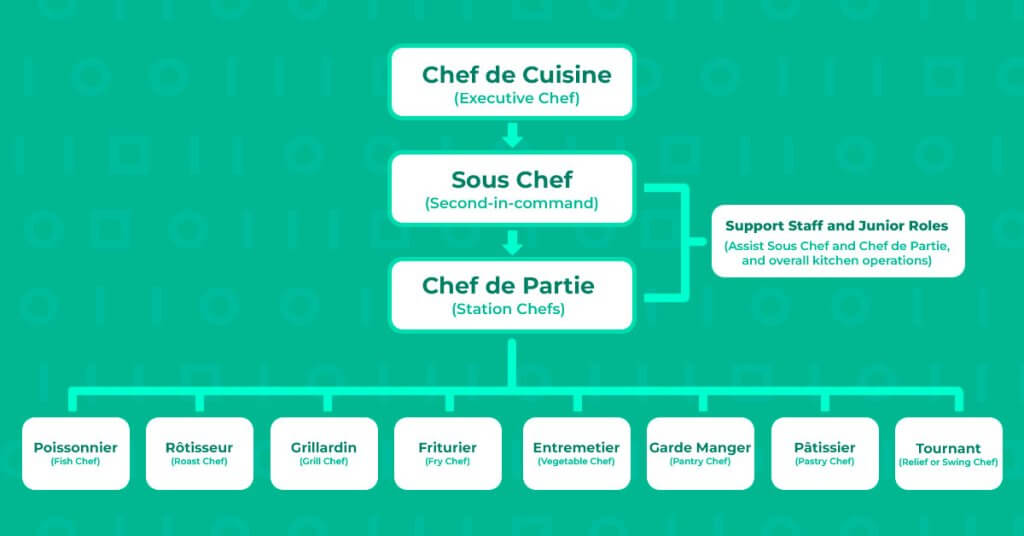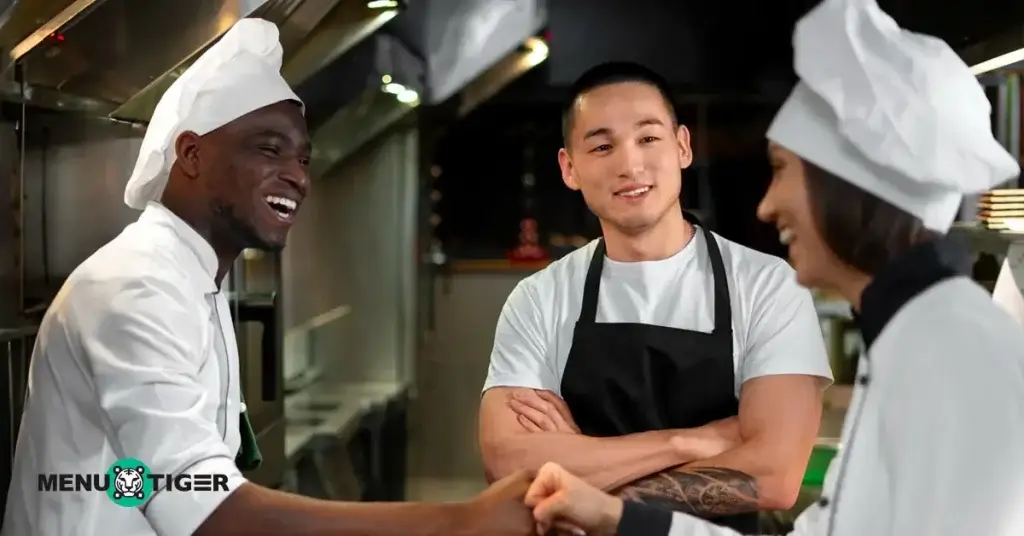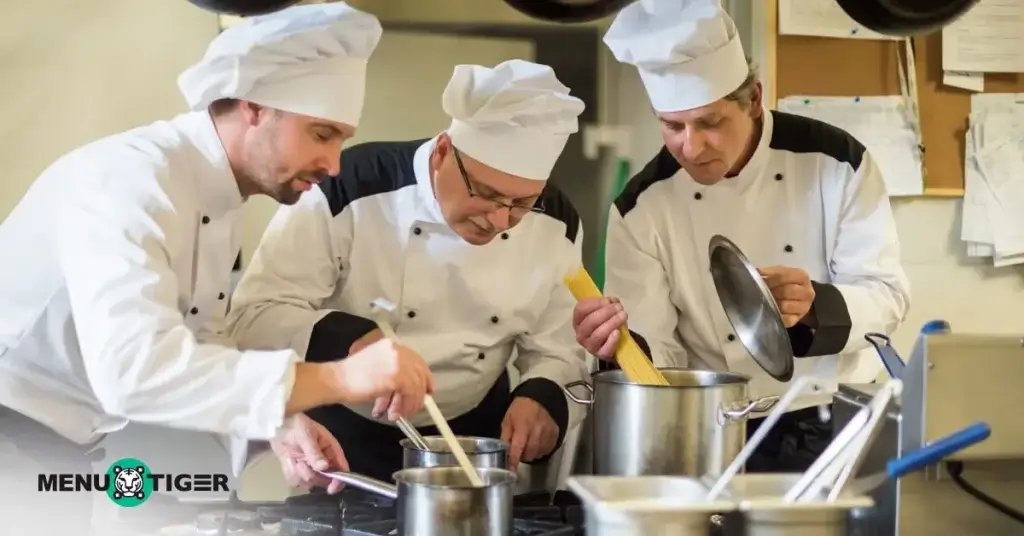
Everything You Need to Know About Kitchen Brigade System
Last Updated: July 24, 2025
The French kitchen brigade system was introduced when Chef Escoffier decided that if an army could stay organized under pressure, so could a kitchen during busy hours.
The idea was adapted to bring structure and discipline to the chaos, giving every cook a clear role and every task its place. It laid the groundwork for smooth restaurant order management system long before point-of-sale systems were even imagined.
This system became the backbone of modern professional kitchens, proving that good food depends not just on skill and creativity but also on organization and teamwork.
What is the kitchen brigade system?
The brigade system organizes a commercial kitchen by assigning each chef and staff member a specific job.
This organized team is known as a brigade, a term borrowed from the military to describe a structured unit working together toward a common goal.
In this setup, each cook functions like a soldier with a clear, specialized task. For example, one prepares sauces, another grills meat, and other handles pastries and desserts.
All team members work systematically under the direction of the head chef, who serves as the commander and ensures every part of the kitchen operates smoothly and in sync.
Who was the French chef given credit for developing the classic brigade system?
Brigade de cuisine was developed in the late 19th century by Georges Auguste Escoffier, a renowned French chef who had served in the army for seven years and during the Franco-Prussian War in 1870-1871.
Seeing how the military structure kept operations efficient under pressure, he applied the same approach to restaurant kitchens, which the system divided into specific stations with clearly defined roles
These included the chef de cuisine, sous-chef, saucier, poissonnier, rôtisseur, entremétier, garde-manger, et pâtissier, among others.
He first introduced this system at the Savoy Hotel in London in the 1890s and later refined it at the Ritz hotels in Paris and London.
Escoffier allowed large kitchens to run with greater efficiency, consistency, and professionalism. His system continues to influence culinary operations around the world today.
Complete hierarchy and job list of the classic brigade system

Each chef leads a specific “station” in the kitchen and is responsible for a particular type of preparation or cooking method.
Their contributions help the kitchen function smoothly and produce high-quality dishes consistently.
1. Chef de Cuisine (Executive chef)
The head of the kitchen. The Chef de Cuisine is responsible for overall management, from planning types of menu to use and managing inventory to leading the team and ensuring high-quality food standards. They work closely with restaurant owners and are rarely involved in daily cooking.
2. Sous Chef (Second-in-command)
The second-in-command, the Sous Chef acts as the right hand of the Executive Chef. They oversee the kitchen staff and all station chefs, ensuring smooth operations during service, and step in whenever the Chef de Cuisine is away.
3. Chef de Partie (Station chefs)
In a well-organized kitchen, every station has a dedicated expert. These chefs, known as chefs de partie, take full ownership of a specific area.
They are highly skilled professionals who ensure that every component of a dish is executed to perfection.
Take a closer look at each of these vital roles:
- Saucier (Sauce Chef): The Saucier holds one of the most skilled and respected roles in the kitchen. This chef is responsible for creating sauces, gravies, stews, and sautéed dishes.
Their work often defines the flavor and complexity of the final plate, making them essential to the heart of fine cuisine.
- Poissonnier (Fish Chef): The Poissonnier is in charge of all seafood preparation, including cleaning, filleting, portioning, and cooking fish and shellfish. They often collaborate with the Saucier to enhance seafood dishes with complementary sauces and sides.
- Rôtisseur (Roast Chef): This chef specializes in roasting and braising meats, often managing large meat cuts and working closely with the butcher.
- Grillardin (Grill Chef): The Grillardin oversees everything cooked on the grill. From steaks and kebabs to grilled vegetables and seafood, this chef masters the art of flame and timing to produce dishes with bold, smoky flavors.
- Friturier (Fry Chef): This chef handles all things fried, from crispy appetizers to golden mains. A Friturier ensures every fried dish comes out perfectly crunchy, hot, and satisfying.
- Entremetier (Vegetable Chef): This chef prepares soups, starches (like rice and potatoes), vegetables, and egg-based dishes.
The Entremetier adds color, texture, and balance to the plate, often rounding out heavier meat or seafood courses with fresh and flavorful sides.
- Garde Manger (Pantry Chef): This chef manages cold dishes, salads, dressings, pâtés, and charcuterie. The Garde Manger combines artistry and precision to bring freshness and flair to the menu.
- Pâtissier (Pastry Chef): The Pâtissier is the dessert specialist of the kitchen. This chef creates sweet treats like pastries, cakes, plated desserts, tarts, and breads.
The role demands artistic flair and scientific accuracy, ensuring that every dessert tastes amazing and looks beautiful.
- Tournant (Relief or Swing Chef): The Tournant is a highly versatile and experienced chef who can fill in at any station as needed.
Whether covering for an absent chef or stepping in during busy service hours, the Tournant is expected to be familiar with all kitchen stations and adapt quickly.
They are key to maintaining kitchen flow during unpredictable moments.
4. Personnel de Soutien (Support staff and junior roles)
These chefs and kitchen staff may not lead a station, but their support is essential to the kitchen's success. They handle prep, cleanliness, order flow, and specialty production.
- Boucher (Butcher): Prepares and portions meats and poultry before they are handed off to the Rôtisseur or other chefs. They also handle trimming, boning, and grinding.
- Confiseur (Confectionner): Specializes in sweets such as candies, chocolates, and sugar work. Often works closely with the Pâtissier to create elegant desserts and garnishes.
- Glacier (Frozen Dessert Chef): Handles frozen treats like ice cream, gelato, sorbets, and frozen mousses. This role requires mastery of temperature control and texture.
- Commis Chef (Junior Cook): A junior chef who assists the station chefs with prep work and basic cooking. This is often a starting point for culinary graduates gaining hands-on experience.
- Apprenti (Apprentice): A trainee, usually from culinary school, who performs entry-level tasks while learning from senior chefs. This is an educational role rather than a full staff position.
- Plongeur (Dishwasher): Ensures all dishes, utensils, cookware, and surfaces are clean and sanitized. This role is crucial for maintaining kitchen hygiene and flow.
- Marmiton (Kitchen Porter): Supports chefs by performing basic prep tasks, cleaning, and restocking. The Marmiton ensures stations stay organized and ready for service.
- Aboyeur (Expeditor): Acts as the link between the kitchen and front-of-house. The Aboyeur calls out orders, coordinates plating, and ensures that dishes are sent out correctly and promptly.

Understanding the brigade hierarchy for a modern kitchen application
Applying the brigade system in today’s kitchens, especially in smaller or more modern setups, does not mean you must strictly follow it by the book.
What matters most is understanding the core roles and adjusting them to fit your team, space, and workflow.
Let’s break it down so you can apply the system in a way that works best for your kitchen:
Executive chef vs. Chef de cuisine
Due to the size and complexity of operations in large restaurant groups or hotel kitchens, the two roles are separate, so they have two defined job descriptions.
But in smaller or independent restaurants, one person often takes on both sets of responsibilities. In these cases, the Chef de Cuisine also serves as the executive staff. This helps reduce labor costs and simplifies communication.
Why do French kitchen brigade structures vary
You might notice that information about the structure can vary, and that’s okay. Not every restaurant needs a traditional French brigade kitchen.
For example, a taco shop might have a tortilla specialist, a protein cook, someone handling garnishes, and support staff responsible for managing tasks like operating the restaurant POS system and assisting during rush hours.
The bottom line: your kitchen doesn’t need to follow the brigade system for structure’s sake. What truly matters is that it fosters teamwork, keeps things organized, and produces great food.
After all, the brigade system was designed to create structure and flow in busy kitchens. Use that same purpose to guide your restaurant’s system, whatever form it takes.
Benefits of the French brigade system in professional kitchens and restaurants
Most people recognize that the brigade system helps with speed and structure.
But many don’t realize that it also quietly fosters healthier, more respectful kitchen culture, builds customer loyalty and sets the foundation for a more successful and scalable restaurant operation.
Here’s how:
In professional kitchens:
1. It creates a clear chain of command
In a busy kitchen, knowing who to report to makes all the difference. The brigade system outlines exactly who is responsible for what. This helps reduce confusion and keeps the team focused, especially during stressful shifts.
2. It helps avoid unnecessary arguments
When each person has a well-defined role, there’s less chance for overlap or misunderstandings. Chefs can focus on their work without stepping on each other’s toes, which creates a calmer and more respectful environment.
3. It builds trust between workmates
Everyone is accountable for their station. This creates a strong sense of ownership and mutual respect. Chefs learn to rely on one another’s expertise, strengthening teamwork and improving service flow.
4. It fosters mentorship and learning
Junior staff members often work directly under more experienced chefs. This setup makes it easier for them to learn by doing, asking questions, and grow in a real-world kitchen environment. It turns every shift into a learning opportunity.
5. It creates a positive kitchen culture

A kitchen with clear structure, teamwork, and mutual respect becomes more than just a workplace. It becomes a space where people feel valued, supported, and motivated to do their best.
In restaurants:
6. Improves inventory and cost control
When each chef sticks to their assigned role, it becomes easier to track how much is being prepped, used, or wasted. This helps reduce spoilage and over-ordering, saving your restaurant money over time.
7. Supports scalable growth
Thinking of expanding your kitchen team or opening another location? The brigade system makes it easier to replicate your kitchen structure and maintain the same standards no matter how big you grow.
8. Creates a professional brand image
A well-organized kitchen shows in your food, your service, and how your team presents themselves. Guests notice the difference. A clear path for staff growth also helps you attract and retain strong talent.
9. Boosts overall efficiency
By using the brigade system, you’re organizing your team and building customer loyalty every time you serve.
With clearly defined roles and a smooth workflow, your kitchen can serve guests more efficiently, minimize errors, and deliver an experiential dining that reflects care, quality, and professionalism.
10. Encourages staff retention and growth
As your restaurant grows or expands to multiple locations, the brigade system provides a repeatable structure. It’s easier to train staff, maintain quality, and replicate operations across kitchens.
How to build a modern kitchen team using the brigade principle

The brigade system may have originated in classical French kitchens, but its structure is still incredibly relevant today. When adapted with a modern mindset, it can help you build an organized, fast, help with restaurant order management system and built kitchen team to last.
1. Understand the core of the Brigade system
While it's clear that the system brings order to the kitchen, truly understanding it allows you to lead with clarity and make smarter operational decisions.
You can spot inefficiencies, assign tasks more effectively, and ensure the right support is in place during peak hours
2. Start small and smart
Avoid common financial mistakes and don't try to implement a 20-person brigade system in your 8-person kitchen. Look at your current team and identify natural leaders who can take on station responsibilities.
Let them help you identify who should lead other stations. People often know their coworkers' strengths better than management, and this approach builds buy-in from your team.
3. Hire for attitude, train for skill
In a modern brigade system, teamwork and reliability are just as crucial as knife skills. So, you should hire a chef who thrives in structured environments, takes feedback well, and is willing to learn.
When interviewing, ask candidates scenario-based questions like, “What would you do if you finished your station work early but saw another chef falling behind?” Their answer will show how well they understand collaboration in a team setting.
4. Define roles but keep your team flexible.
While each person should have their primary station, cross-train your team so they can help elsewhere when needed.
Real kitchens don’t always follow a rigid script, even with set stations. A grill cook might need to help with salads, and the prep cook might jump into dishwashing during a rush. That’s why it’s smart to cross-train your team.
5. Embrace restaurant ordering software

The original brigade system didn’t include kitchen display screens or order management tools.
Today, modern technology like ordering software, QR code menus, and even a restaurant website helps kitchens run more smoothly by improving communication between the front and back of house.
Build a more efficient kitchen with the brigade system
Even though the kitchen brigade system was created over a century ago, it still plays a big role in how kitchens run today.
It brought structure to what could easily become chaos and helped teams work together with clarity and purpose.
You don’t need a fancy or massive kitchen to make it work. Whether you’re running a small neighborhood café or a growing restaurant, the heart of the system is the same: clear roles, teamwork, and a smoother flow.
These all contribute to a better order management and a more efficient kitchen overall.

FAQS
Eulla
Eulla joined MENU TIGER’s Content Team with a foundation in English teaching. She combines language expertise and creativity to produce engaging content that educates audiences and drives meaningful results.


